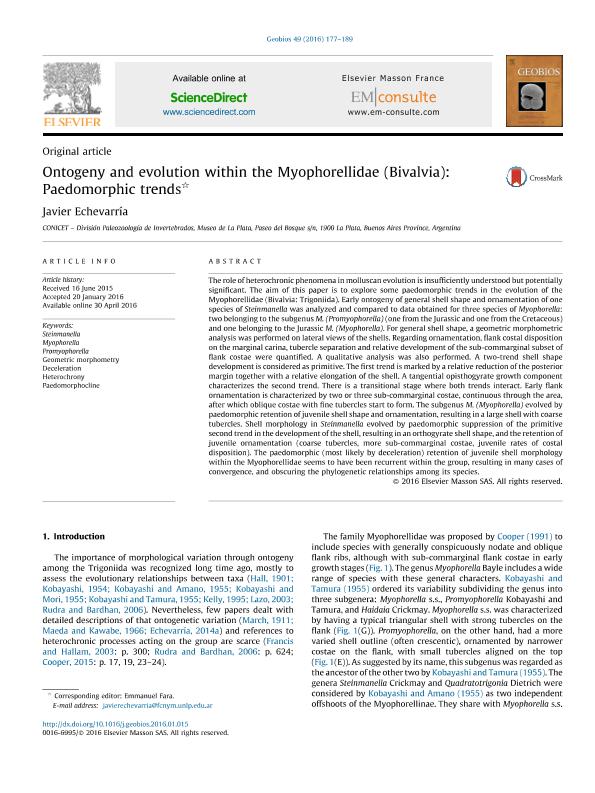Mostrar el registro sencillo del ítem
dc.contributor.author
Echevarría, Javier

dc.date.available
2018-08-08T15:30:38Z
dc.date.issued
2016-05
dc.identifier.citation
Echevarría, Javier; Ontogeny and evolution within the Myophorellidae (Bivalvia): Paedomorphic trends; Elsevier France-editions Scientifiques Medicales Elsevier; Geobios; 49; 3; 5-2016; 177-189
dc.identifier.issn
0016-6995
dc.identifier.uri
http://hdl.handle.net/11336/54556
dc.description.abstract
The role of heterochronic phenomena in molluscan evolution is insufficiently understood but potentially significant. The aim of this paper is to explore some paedomorphic trends in the evolution of the Myophorellidae (Bivalvia: Trigoniida). Early ontogeny of general shell shape and ornamentation of one species of Steinmanella was analyzed and compared to data obtained for three species of Myophorella: two belonging to the subgenus M. (Promyophorella) (one from the Jurassic and one from the Cretaceous) and one belonging to the Jurassic M. (Myophorella). For general shell shape, a geometric morphometric analysis was performed on lateral views of the shells. Regarding ornamentation, flank costal disposition on the marginal carina, tubercle separation and relative development of the sub-commarginal subset of flank costae were quantified. A qualitative analysis was also performed. A two-trend shell shape development is considered as primitive. The first trend is marked by a relative reduction of the posterior margin together with a relative elongation of the shell. A tangential opisthogyrate growth component characterizes the second trend. There is a transitional stage where both trends interact. Early flank ornamentation is characterized by two or three sub-commarginal costae, continuous through the area, after which oblique costae with fine tubercles start to form. The subgenus M. (Myophorella) evolved by paedomorphic retention of juvenile shell shape and ornamentation, resulting in a large shell with coarse tubercles. Shell morphology in Steinmanella evolved by paedomorphic suppression of the primitive second trend in the development of the shell, resulting in an orthogyrate shell shape, and the retention of juvenile ornamentation (coarse tubercles, more sub-commarginal costae, juvenile rates of costal disposition). The paedomorphic (most likely by deceleration) retention of juvenile shell morphology within the Myophorellidae seems to have been recurrent within the group, resulting in many cases of convergence, and obscuring the phylogenetic relationships among its species.
dc.format
application/pdf
dc.language.iso
eng
dc.publisher
Elsevier France-editions Scientifiques Medicales Elsevier

dc.rights
info:eu-repo/semantics/openAccess
dc.rights.uri
https://creativecommons.org/licenses/by-nc-sa/2.5/ar/
dc.subject
Deceleration
dc.subject
Geometric Morphometry
dc.subject
Heterochrony
dc.subject
Myophorella
dc.subject
Paedomorphocline
dc.subject
Promyophorella
dc.subject
Steinmanella
dc.subject.classification
Meteorología y Ciencias Atmosféricas

dc.subject.classification
Ciencias de la Tierra y relacionadas con el Medio Ambiente

dc.subject.classification
CIENCIAS NATURALES Y EXACTAS

dc.title
Ontogeny and evolution within the Myophorellidae (Bivalvia): Paedomorphic trends
dc.type
info:eu-repo/semantics/article
dc.type
info:ar-repo/semantics/artículo
dc.type
info:eu-repo/semantics/publishedVersion
dc.date.updated
2018-08-08T14:59:40Z
dc.journal.volume
49
dc.journal.number
3
dc.journal.pagination
177-189
dc.journal.pais
Francia

dc.journal.ciudad
Paris
dc.description.fil
Fil: Echevarría, Javier. Consejo Nacional de Investigaciones Científicas y Técnicas; Argentina. Universidad Nacional de La Plata. Facultad de Ciencias Naturales y Museo. División Paleozoología Invertebrados; Argentina
dc.journal.title
Geobios

dc.relation.alternativeid
info:eu-repo/semantics/altIdentifier/doi/https://dx.doi.org/10.1016/j.geobios.2016.01.015
dc.relation.alternativeid
info:eu-repo/semantics/altIdentifier/url/https://www.sciencedirect.com/science/article/pii/S0016699516300109
Archivos asociados
